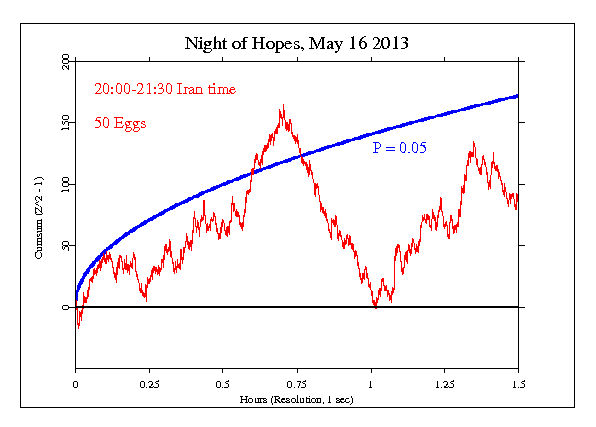|
I received an email on May 16 from Yasin AbedRabboh saying "I would like
to suggest the "night of hopes", a muslim occasion today
as an event for the project. It is more practiced by shiites so maybe the
Irani timezone is best."
Since I was not familiar with the event, I responded, "Please give the
specific time (including time zone) the event would begin and end so we
can identify the corresponding segment of the data stream. Please also
give me an Internet source where I can learn about the event and get a
reasonable estimate of the number of people who will participate and how
much of the world will be engaged." She sent the following
information.
Dear Dr. Nelson,
Thank you for your reply. The night is the first Thursday of of the
lunar month "Rajab" which was May 16th 2013. On that day many muslims,
especially Shiites fast the whole Thursday from sunrise to sunset then
proceed to perform the special prayer between the sunset prayer and the
night prayer which in Irani time is between 8 pm and 9:30 pm, 3:30 pm
GMT and 5pm GMT on may 16th.
Hope that helps, please let me know if you have any other questions.
There is also another period of 10 days which all Muslim sects take
seriously and that is the last 10 days of the month of Ramadan
especially the odd ones, coming up in about 2months. The night of qadr
(destiny). Thank you for your time and work.
Sincerely,
Yasin
Although it is a shorter period of time than we usually assess, the
specification was clear and precise, and the
GCP event was set as Yasin indicated. The result is
Chisquare 5494.157 on 5400 for p = 0.182 and Z = 0.907. (Note: these
values are corrected from an earlier calculation which was in error.)

It is important to keep in mind that we have only a tiny
statistical effect, so that it is always hard to distinguish
signal from noise. This means that every "success" might be
largely driven by chance, and every "null" might include a real
signal overwhelmed by noise. In the long run, a real effect can
be identified only by patiently accumulating replications of
similar analyses.
|